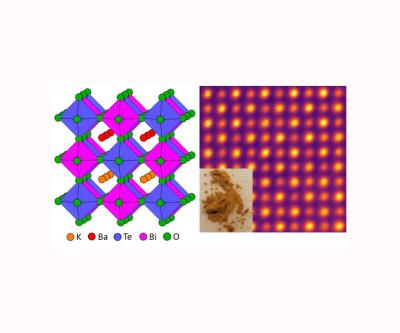A team of scientists at Washington University in St. Louis has found what may be a more stable, less toxic semiconductor for solar applications using a novel double perovskite oxide, discovered through data analytics and quantum-mechanical calculations.
 An atomic model of KBaTeBiO6 (left), scanning transmission electron micrograph showing the atomic structure of KBaTeBiO6, along with snapshot of the synthesized powder (right). Credit: WUSTL
An atomic model of KBaTeBiO6 (left), scanning transmission electron micrograph showing the atomic structure of KBaTeBiO6, along with snapshot of the synthesized powder (right). Credit: WUSTL
Rohan Mishra, assistant professor of mechanical engineering & materials science in the McKelvey School of Engineering, led an interdisciplinary, international team that discovered the new semiconductor, made up of potassium, barium, tellurium, bismuth and oxygen (KBaTeBiO6). The lead-free double perovskite oxide was one of an initial 30,000 potential bismuth-based oxides. Of those 30,000, only about 25 were known compounds.
'We found that this looked to be the most stable compound and that it could be synthesized in the lab,' Mishra said. 'More importantly, whereas most oxides tend to have a large band, we predicted the new compound to have a lower band gap, which is close to the halide perovskites, and to have reasonably good properties.'
Mishra discussed the possibility of synthesizing KBaTeBiO6 with Pratim Biswas, assistant vice chancellor, the Lucy & Stanley Lopata Professor and chair of the Department of Energy, Environmental & Chemical Engineering. Shalinee Kavadiya, then a McKelvey Engineering doctoral student and now a postdoctoral research associate at Arizona State University, got to work on perfecting the recipe.
'Shalinee spent about six months synthesizing the material,' Mishra said. 'Once she was able to synthesize it, as we had predicted, it was stable and had a band gap of 1.88 eV, which we also predicted.'
Mishra said these are first-generation solar cells that need more fine tuning of the band gap, but it is a good first step toward nontoxic solar cells.
'This shows that we can go away from these lead-halide perovskites,' Mishra said. 'This opens up a really big space for designing semiconductors not just for solar cell applications but also for other semiconductor applications, such as LCD displays.'
Next, the team will study the role of any defects in this new semiconductor and look to more advanced synthesis techniques, including using aerosol techniques.



